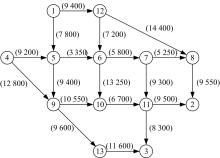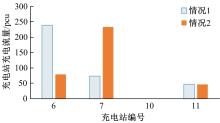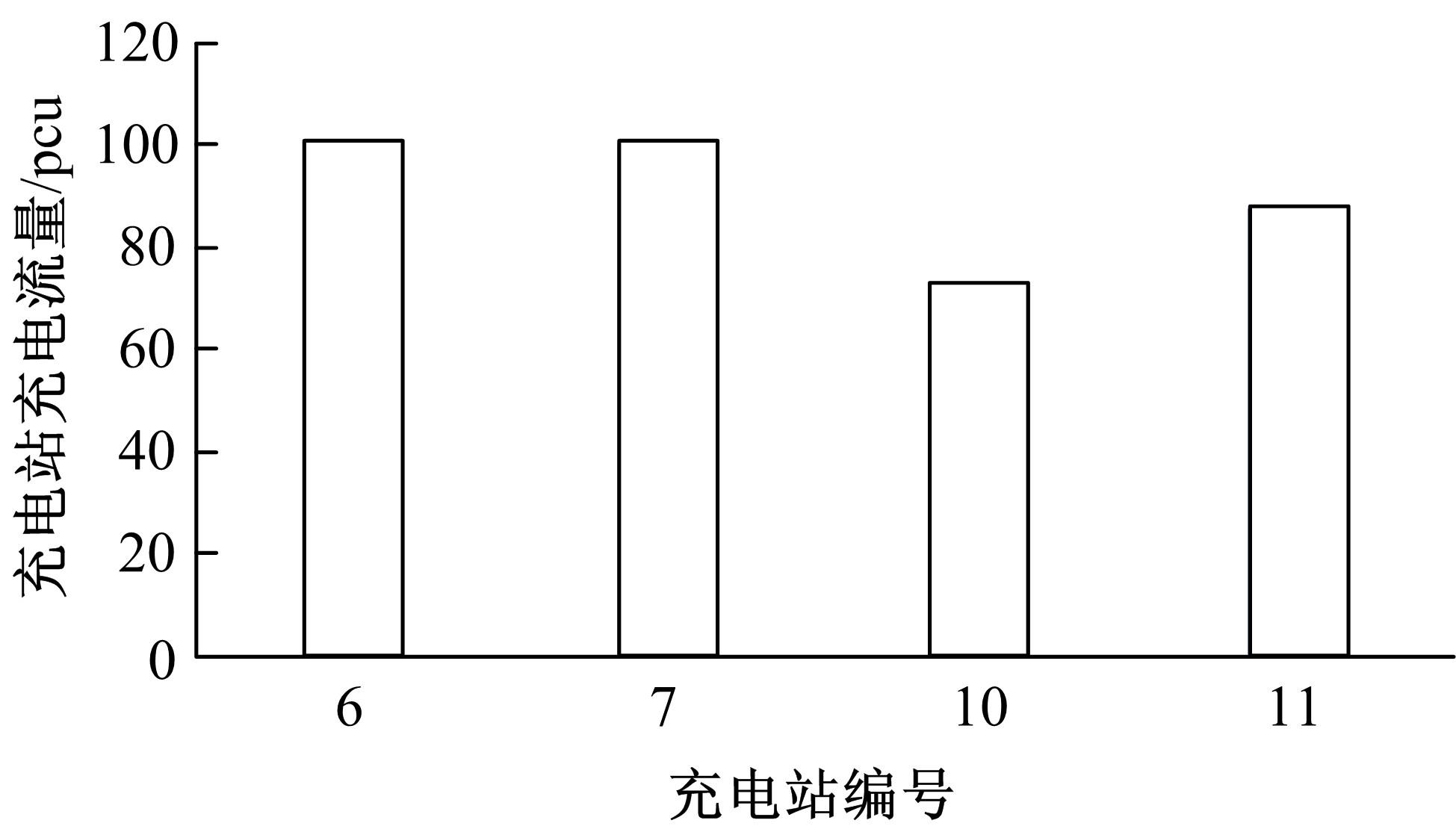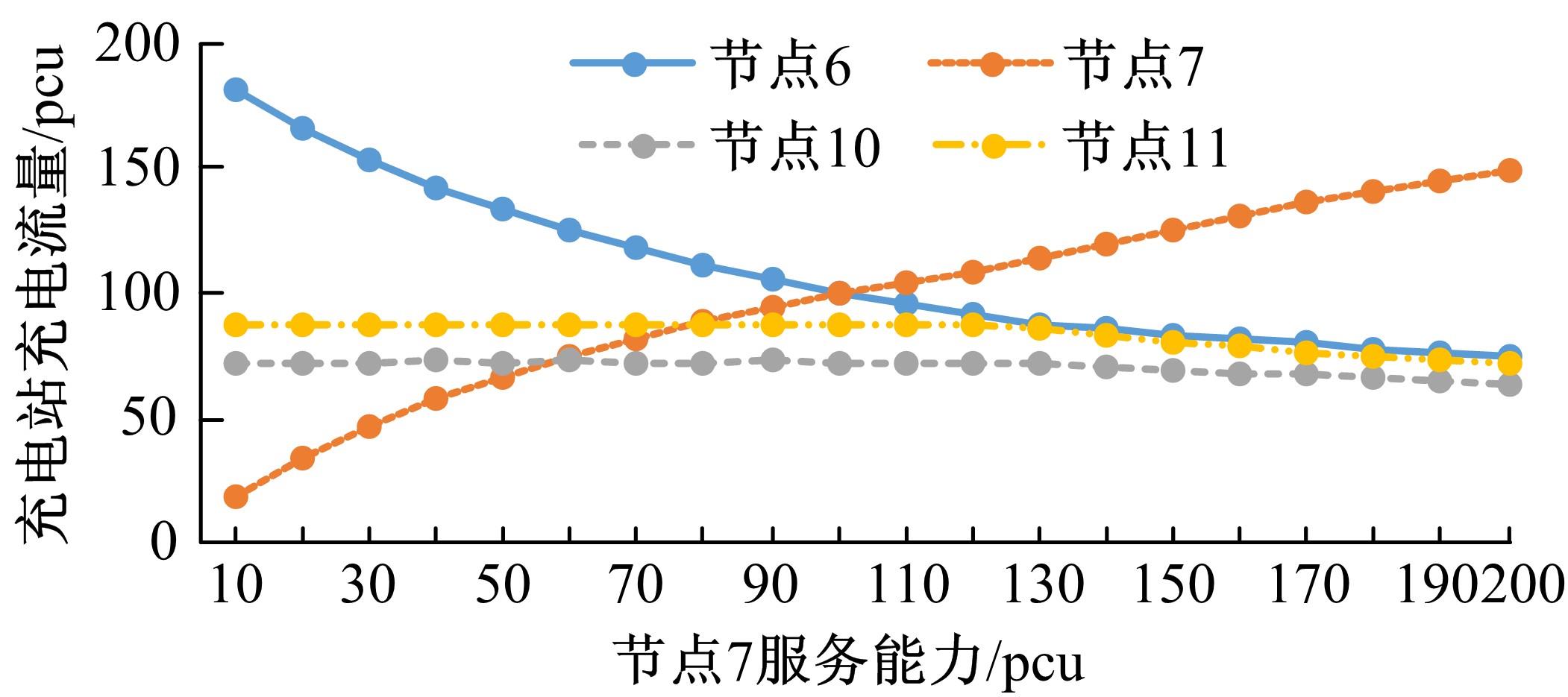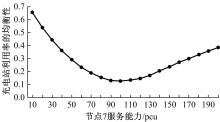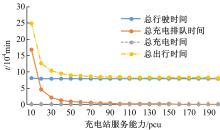吉林大学学报(工学版) ›› 2021, Vol. 51 ›› Issue (5): 1684-1691.doi: 10.13229/j.cnki.jdxbgxb20200421
• 交通运输工程·土木工程 • 上一篇
考虑充电排队时间的电动汽车混合交通路网均衡
- 1.同济大学 交通运输工程学院,上海 201804
2.同济大学 道路与交通工程教育部重点实验室,上海 201804
Mixed traffic network equilibrium with battery electric vehicles considering charging queuing time
- 1.College of Transportation Engineering,Tongji University,Shanghai 201804,China
2.Key Laboratory of Road and Traffic Engineering of the Ministry of Education,Tongji University,Shanghai 201804,China
摘要:
为分析充电排队时间对电动汽车用户路径选择以及路网均衡的影响,分别考虑充电排队时间与充电站充电流量、充电时间与充电量的关系,构建了相应的混合交通路网模型。证明了解的唯一性,并推导了混合交通网络模型对应的KKT条件,证明其与Wardrop第一原理等价。基于梯度投影法设计了求解算法,构建了一个算例验证了模型及算法的有效性。研究结果表明:固定排队时间下的最优解对应的充电站充电流量分布不唯一,非固定排队时间下的最优解对应的充电站充电流量分布唯一。在非固定排队时间下,电动汽车用户为了规避过长的充电排队时间,充电站充电流量分布会更加均衡;服务能力对充电站利用率的均衡性有显著影响;路网的总充电排队时间以及总出行时间随充电站服务能力的增大而逐渐减少。
中图分类号:
- U491.2
| 1 | 范光辉, 余剑武, 罗红, 等. 混合动力汽车电池性能影响因素分析与试验[J]. 吉林大学学报: 工学版, 2019, 49(5): 1451-1458. |
| Fan Guang-hui, Yu Jian-wu, Luo Hong, et al. Influencing factors analysis and experimental study of battery performances in hybrid electric vehicle[J]. Journal of Jilin University (Engineering and Technology Edition), 2019, 49(5): 1451-1458. | |
| 2 | 姚亮, 初亮, 周飞鲲, 等. 纯电动轿车制动能量回收节能潜力仿真分析[J]. 吉林大学学报: 工学版, 2013, 43(1): 11-16. |
| Yao Liang, Chu Liang, Zhou Fei-kun, et al. Simulation and analysis of potential of energy-saving from braking energy recovery of electric vehicle[J]. Journal of Jilin University(Engineering and Technology Edition), 2013, 43(1): 11-16. | |
| 3 | 孙跃, 田勇, 苏玉刚, 等. 电动车无线能量互充系统及其恒流控制[J]. 吉林大学学报: 工学版, 2013, 43(2): 491-496. |
| Sun Yue, Tian Yong, Su Yu-gang, et al. Wireless vehicle-to-vehicle power exchange system and its constant current control[J]. Journal of Jilin University(Engineering and Technology Edition), 2013, 43(2): 491-496. | |
| 4 | Jiang N, Xie C, Waller T. Path-constrained traffic assignment: model and algorithm[J]. Transportation Research Record Journal of the Transportation Research Board, 2012, 2283: 25-33. |
| 5 | Jiang N, Xie C. Computing and analyzing mixed equilibrium network flows with gasoline and electric vehicles[J]. Computer Aided Civil & Infrastructure Engineering, 2014, 29(8): 626-641. |
| 6 | Jing W, Kim I, Ramezani M, et al. Stochastic traffic assignment of mixed electric vehicle and gasoline vehicle flow with path distance constraints[J]. Transportation Research Procedia, 2017, 21: 65-78. |
| 7 | Wang T G, Xie C, Xie J, et al. Path-constrained traffic assignment: a trip chain analysis under range anxiety[J]. Transportation Research Part C: Emerging Technologies, 2016, 68: 447-461. |
| 8 | Xie C, Wang T G, Pu X, et al. Path-constrained traffic assignment: modeling and computing network impacts of stochastic range anxiety[J]. Transportation Research Part B: Methodological, 2017, 103: 136-157. |
| 9 | He F, Yin Y, Lawphongpanich S. Network equilibrium models with battery electric vehicles[J]. Transportation Research Part B: Methodological, 2014, 67: 306-319. |
| 10 | 杨扬, 姚恩建, 王梅英, 等. 电动汽车混入条件下的随机用户均衡分配模型[J]. 中国公路学报, 2015, 28(9): 91-97. |
| Yang Yang, Yao En-jian, Wang Mei-ying, et al. Stochastic user equilibrium assignment model for electric vehicle under hybrid traffic condition[J]. China Journal of Highway and Transport, 2015, 28(9): 91-97. | |
| 11 | 邵赛, 关伟, 毕军. 考虑排队时间和里程约束的竞争充电站选址问题[J]. 交通运输系统工程与信息, 2016, 16(6): 169-175. |
| Shao Sai, Guan Wei, Bi Jun. Charging station location problem with queue and range in competitive multi-site service system[J]. Journal of Transportation Systems Engineering and Information Technology, 2016, 16(6): 169-175. | |
| 12 | 杨恬恬. 车-路-站多信息交互下电动汽车充电路径规划[D]. 北京: 北京交通大学电气工程学院, 2019. |
| Yang Tian-tian. Study on the design of a new type of collision energy absorbing device for rail vehicles[D]. Beijing: College of Electrical Engineering, Beijing Jiaotong University, 2019. | |
| 13 | Xu M, Meng Q, Liu K. Network user equilibrium problems for the mixed battery electric vehicles and gasoline vehicles subject to battery swapping stations and road grade constraints[J]. Transportation Research Part B: Methodological, 2017, 99: 138-166. |
| 14 | Liu Z, Song Z. Network user equilibrium of battery electric vehicles considering flow-dependent electricity consumption[J]. Transportation Research Part C Emerging Technologies, 2018, 95: 516-544. |
| 15 | Franke T, Neumann I, Bühler F, et al. Experiencing range in an electric vehicle: understanding psychological barriers[J]. Applied Psychology, 2012, 61(3): 368-391. |
| 16 | Smart J, Schey S. Battery electric vehicle driving and charging behavior observed early in the EV project[J]. Sae International Journal of Alternative Powertrains, 2012, 1(1): 27-33. |
| 17 | Zhang Y, Aliya B, Zhou Y, et al. Shortest feasible paths with partial charging for battery-powered electric vehicles in smart cities[J]. Pervasive and Mobile Computing, 2018, 50: 82-93. |
| 18 | Wang T, Cassandras C G, Pourazarm S. Energy-aware vehicle routing in networks with charging nodes[J]. Ifac Proceedings Volumes, 2014, 47(3): 9611-9616. |
| 19 | Pourazarm S, Cassandras C G, Andreas M. Optimal routing of electric vehicles in networks with charging nodes: a dynamic programming approach[C]∥IEEE International Electric Vehicle Conference. Florence, Italy: IEEE, 2014: 1-7. |
| 20 | Jayakrishnan R, Tsai W T, Prashker J N, et al. A faster path-based algorithm for traffic assignment[J]. University of California Transportation Center, Working Papers, 1994, 1443: 75-83. |
| [1] | 户佐安,夏一鸣,蔡佳,薛锋. 延误条件下综合多种策略的城轨列车运行调整优化[J]. 吉林大学学报(工学版), 2021, 51(5): 1664-1672. |
| [2] | 王聪,马彦,王国光. 电动汽车充电站内的实时最优功率分配[J]. 吉林大学学报(工学版), 2021, 51(4): 1490-1495. |
| [3] | 宋强,孙丹婷,章伟. 纯电动车机械式自动变速器换挡非线性建模及控制[J]. 吉林大学学报(工学版), 2021, 51(3): 810-819. |
| [4] | 朱才华,孙晓黎,李岩. 站点分类下的城市公共自行车交通需求预测[J]. 吉林大学学报(工学版), 2021, 51(2): 531-540. |
| [5] | 沈军,周晓,吉祖勤. 服务动态扩展网络及其结点系统模型的实现[J]. 吉林大学学报(工学版), 2019, 49(6): 2058-2068. |
| [6] | 马苗苗,潘军军,刘向杰. 含电动汽车的微电网模型预测负荷频率控制[J]. 吉林大学学报(工学版), 2019, 49(5): 1644-1652. |
| [7] | 罗清玉,田万利,贾洪飞. 考虑通勤需求的电动汽车充电站选址与定容模型[J]. 吉林大学学报(工学版), 2019, 49(5): 1471-1477. |
| [8] | 席利贺,张欣,孙传扬,王泽兴,姜涛. 增程式电动汽车自适应能量管理策略[J]. 吉林大学学报(工学版), 2018, 48(6): 1636-1644. |
| [9] | 常成,宋传学,张雅歌,邵玉龙,周放. 双馈电机驱动电动汽车变频器容量最小化[J]. 吉林大学学报(工学版), 2018, 48(6): 1629-1635. |
| [10] | 金立生, 谢宪毅, 高琳琳, 郭柏苍. 基于二次规划的分布式电动汽车稳定性控制[J]. 吉林大学学报(工学版), 2018, 48(5): 1349-1359. |
| [11] | 曹骞, 李君, 刘宇, 曲大为. 基于马尔科夫链的长春市乘用车行驶工况构建[J]. 吉林大学学报(工学版), 2018, 48(5): 1366-1373. |
| [12] | 孙宝凤, 高坤, 申琇秀, 梁婷. 基于能力平衡和变覆盖半径的加油站网络扩充选址模型[J]. 吉林大学学报(工学版), 2018, 48(3): 704-711. |
| [13] | 张天时, 宋东鉴, 高青, 王国华, 闫振敏, 宋薇. 电动汽车动力电池液体冷却系统构建及其工作过程仿真[J]. 吉林大学学报(工学版), 2018, 48(2): 387-397. |
| [14] | 孙文, 王庆年, 王军年. 基于横摆力矩控制的电动轮汽车转弯节能控制[J]. 吉林大学学报(工学版), 2018, 48(1): 11-19. |
| [15] | 邵赛, 毕军, 关伟. 基于电动汽车的动态需求车辆路径问题[J]. 吉林大学学报(工学版), 2017, 47(6): 1688-1695. |
|
||

